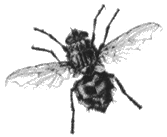
![]()
![]()
![]()
|
They come in the morning when you are fast asleep. A light breath and then - tickle, tickle tickle. You swat yourself but the fly flies away and is soon back. Irritating, aren't they? They can fly in any direction, forwards, sideways, backwards, yes, even upwards and downwards.
The only way to be quicker than a fly is to use a fly-swatter. But smashing a fly can be rather disgusting indeed. You don't very well hit the bread plate, even if you kill two flies in one attempt. To flick them away with your middle finger and thumb could be successful with the big, slow kind. Sometimes you succeed and the fly spins dizzily a few rounds on the floor before it takes off again towards new heights, if your heel isn't there quickly enough. Most people wave their hands after the fly in something which in military terms is called a dog curve, i.e. a curve like when a dog hunts a hare. If you are bright you realize and if you are not you notice that this isn't very successful. A better hunting method is a direct attack, which means aiming at the spot where the fly will be at the time of the actual smash. This requires the use of both hands. You approach the fly with your palms from both sides which steers the fly's escape straight upwards, and then you smash. If you aim not right above the fly but a little bit diagonally upwards, you usually succeed.The method has the disadvantage of making it necessary to wash both hands afterwards, which is really an advantage since it is considerably easier than washing just one hand. In my youth there was fly paper, a sticky brown strip of paper which you pulled from a roll and hung up in a suitable place. To the flies it looked tasty, something like sirrup, and so they stuck when landed hungrily and got helplessly caught. Some of them realized their mistake and tried to turn back but too late and so were stuck upside down. Torture, cried the weak-minded and the paste rolls disappeared. Was the the R.S.P.C.A. intervening? These paste strips also proved very effective to use when catching little children. For a while I caught flies using psychology. One hand is held in front of the fly and is moved from side to side to distract the fly. At the same time the other hand comes sneaking from behind and before you know how there is a buzzing souund in your hand. The difficulty is to kill the fly without letting it escape between your fingers and without smearing your hand. Nowadays I have started to use the vacuum cleaner method. You slowly approach the fly with the tube. Too Iate it discovers the danger and a small vibration in the tube is proof of the successful catch. But you mustn't go too straight on because then it flies away too early, but come upon it slowly from one side. Nor is it advisable to approach it from above but the best method is to make the fly believe it has a free escape. In good hunting grounds the catch can be considerable. One day I counted nearly a hundred. How to prevent them from creeping out through the tube and be caught several times will have to be the subject of my next research study. Lars Cornell |